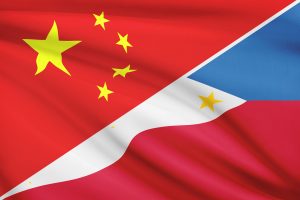The Philippine Navy has successfully resupplied forces stationed in a grounded vessel on a disputed shoal in the South China Sea, two weeks after Chinese Coast Guard vessels blocked a routine rotation and resupply mission.
In a statement yesterday, the National Task Force for the West Philippine Sea (as Manila terms its portions of the disputed waterway) announced that the navy had “successfully conducted” the mission to resupply the unit of soldiers based aboard the BRP Sierra Madre.
“The latest RoRe mission was able to deliver fresh provisions to our military personnel stationed on board BRP SIERRA MADRE,” the statement said, despite attempts by China Coast Guard and maritime militia “to block, harass, and interfere with the supply mission.”
The Task Force said that it “commends the unfailing valor, determination, and professionalism” of the Armed Forces of the Philippines (AFP) and the Philippine Coast Guard (PCG), which carried out the mission.
On August 5, China’s Coast Guard blocked and shot a water cannon at a Philippine navy-chartered supply boat in the vicinity of Second Thomas Shoal, which Manila refers to as Ayungin Shoal and Beijing as Ren’ai Jiao. As a result, it was forced to abandon its attempts to resupply the Sierra Madre, a decrepit World War II-era ship, which was intentionally grounded in the shoal’s shallow waters in 1999, in response to China’s occupation of nearby Mischief Reef in 1994.
The Chinese actions prompted strongly worded protests from both the AFP and PCG, and the Foreign Ministry’s summoning of Chinese ambassador Huang Xilian. It also elicited strong condemnations from partners and allies of the Philippines, including the United States. This month’s incident came after a similar confrontation in February, when the PCG accused a Chinese coast guard ship of hitting a Philippine coast guard vessel with a military-grade laser in a successful attempt to prevent it from approaching the shoal.
Second Thomas Shoal lies well within the Philippines’ 200-nautical-mile exclusive economic zone, but China claims a large part of it under its expansive “nine-dash line” maritime claim. For its own part, the Chinese government this month accused the Philippines of “transporting construction materials” to the Sierra Madre “with the intent of permanently occupying” the shoal, and claims that it violated an earlier agreement to remove the grounded ship. (Manila denies that any such agreement was made.)
Beijing has clearly chosen Second Thomas Shoal as a focus of its “grey zone” activities, which are designed to advance China’s control over the waters lying within the “nine-dash line” without provoking an outright conflict. One likely reason for this is the uncertain condition of the Sierra Madre, which could be one significant storm away from crumbling into the aquamarine waters of the atoll, opening an opportunity for China to assume control of the feature – as it did with Scarborough Shoal in 2012.
Yesterday’s mission was a successful show of resolve on the part of the Philippines, which achieved its immediate objective of resupplying the troops aboard the rusting ship, in the face of a large asymmetry of power.
But as Evan Laksmana wrote in The Straits Times this week, the “breaking” of what some have termed as the Chinese “blockade” of Second Thomas Shoal only raises the question of the next steps. As Laksmana argues, only the clever marshaling of military and diplomatic resources can ensure that the feature remains in Philippine hands for the long term.
“Just as Beijing often sees crises as opportunities,” he wrote, “so too should Manila use the latest incident to ignite not only a wider internal defense and maritime security transformation, but also a more concerted effort to strengthen the regional rules-based maritime order.”

































